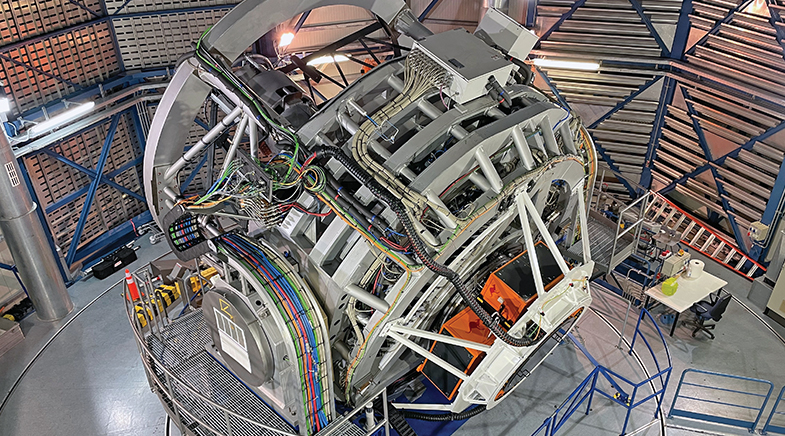The roots of rage
-
- from Shaastra :: vol 02 issue 02 :: Mar - Apr 2023

A new study throws light on the nature of aggression.
Ever slammed a door, yelled at a road hog, banged down the phone on a telemarketer or kicked a chair? You know why you get angry — now science is telling you how.
Scientists, at long last, have an explanation for what happens in the brain during a rage-like situation. The mystery was resolved, with the help of a machine-learning technique, by a team of researchers led by David Anderson, the Seymour Benzer Professor of Biology at the California Institute of Technology. The findings were reported in the journal Cell in January 2023.

Aggression is vital for survival in the animal kingdom. Animals fight for mates, to protect their families and safeguard territories. At the same time, they often size up a rival and back down when they realise the opponent has a better chance of winning a fight.
Neuroscientists have known for a while that such emotions are governed by the hypothalamus — the highly conserved region of the brain that acts as the body's smart control and coordination centre. Despite its pea-like size in human brains, this subcortical region plays a vital role in keeping the body in a stable state called homeostasis. It does this by influencing the autonomous nervous system or by managing hormones.
The hypothalamus is linked to many instinctive survival behaviours such as mating, hunting and the fight-or-flight response. Because animals, including humans, have to get these actions just right to be able to survive, these are hard-wired into the brain.
Scientists have long believed that neurons in the hypothalamus are functionally specific, that is, certain groups of neurons encode certain behaviours. For instance, neurons in the medial preoptic area (MPOA) of the hypothalamus, when stimulated, cause a male mouse to mount a female mouse, or vice versa.
Researchers studying neurobiology of aggression, however, have not had similar experimental success. Even though they rightly identified the neurons involved in aggression in a hypothalamic subregion, they failed to observe the firing of those neurons in a real situation for a long time.
NEW FINDING
But now Anderson and his team, which includes Ann Kennedy, a former postdoc in Anderson's lab and now an Assistant Professor at Northwestern University in Chicago, have found something remarkable. There is, their study says, a "ramping up" in the neurons when animals undergo different stages of aggressive behaviour.
Significantly, it was Anderson's group that had identified neurons involved in aggressive behaviour some 12 years ago. They had used advances in the then new field of optogenetics — which allowed researchers to instantaneously activate or silence a specific group of neurons within circuits with precision by shining a laser on them. With this method, the team in 2011 had demonstrated that the neurons in the ventrolateral part of the ventromedial hypothalamus (VMHvl) could be stimulated to make a male mouse attack another male mouse. VMHvl, an area adjoining MPOA, was established as the brain's attack centre.

Since then, Anderson's lab and scientists elsewhere have been trying to unravel the exact mechanism by which VMHvl neurons trigger aggression in animals. Lab experiments, however, failed to catch the firing of the VMHvl neurons in rodents that were fighting naturally, even though it was earlier found that the stimulation of these neurons made animals attack one another.
When their tests failed to elicit the expected results, the Caltech scientists went in for more innovative ways. One of the methods before them was an Artificial Intelligence-driven approach. Such a machine learning-based approach, even though commonly used to study more complex brain regions such as the cortex or the hippocampus, which are linked to motor control or memory, had not been applied in studies relating to the hypothalamus.
This was perhaps because neuroscientists in the past saw the hypothalamus as a simple structure, unlike the cortex, which was considered the seat of intelligence. As a result, they largely used standard tools in genetics and molecular biology to study the hypothalamus.
"We initially thought that if we go down to VMHvl and report the activity of neurons there while the animals are doing the aggressive acts, we would see a lot of neurons turned on. But in reality, we found that no neuron in that structure was turning on during aggression. This was very surprising," says Aditya Nair, a PhD student at Anderson's lab and the first author of the Cell paper.
This, he adds, was counter-intuitive to what the researchers had expected. "The decade-long work done in the field was telling us that that region is so important for aggression," he says.
DYNAMIC MODEL SYSTEM
Then, working closely with Scott Linderman and Surya Ganguli, Stanford University Professors with expertise in machine learning, the Caltech team developed a dynamic system model to analyse data collected from their experiments with rodent brains.
"The dynamical system acts like an artificial mouse brain in a computer which reflects our experimental observations. We then studied this model in depth to learn how these hundreds of neurons talk to one another," Nair says.

The team also broke down the complex nonlinear neural network into a number of linear networks. Nonlinear networks produce excellent results, but they are not suitable if scientists want to understand the processes involved. This is because the input goes through a complex, nonlinear, high-dimensional algorithm, making it hard for scientists to understand how the neural network arrives at the output, or answer.
Nair explains that with experts such as Linderman and Ganguli working with them, the Caltech team thought it could approximate this nonlinear system into a bunch of different linear systems that interacted with each other. Using the model, the scientists tried to understand how the VMHvl neurons’ firing activity changes over time.
Anderson and his team have found something remarkable: a "ramping up" in neurons when animals undergo different stages of aggressive behaviour.
The model revealed the "ramping up" in the neurons during aggression. Instead of firing concerned neurons all at once, there was a gradual increase in the firing as the animal went through the aggressive stages — starting with sniffing, then putting on a threatening display to mounting on one another, and then to a full-blown attack.
The dynamic system model that the Caltech scientists used captured this ramping up in neuronal activity well.
SHAPE OF A TROUGH
In the paper in Cell, the scientists reported a "line attractor" — a mathematical representation of a pattern — that emerges in the VMHvl region, which encodes for aggression. When plotted in an energy landscape, the line attractor formed the shape of a trough. Though the trough is not a physical structure in the brain, it indicates the flow of energy happening in the dynamical system.
Mice typically show aggressive behaviour when another male mouse is introduced to their cage during experiments. Their behaviour escalates from threatening displays to mounting to a full-blown attack, a sliding-scale trajectory that can be explained by line-attractor dynamics. As neural activity progressed along the line-attractor trough, the mouse's aggression ramped up.
The shape of the trough made it simple for the brain to modulate aggression — like a volume knob that can be turned up or down. If the "volume" gets too high, animals attack. The lower part of the trough is where the aggression is at its peak.
This modulation may serve as an evolutionary adaptation, compelling animals to measure out displays of aggression and test the waters before going into a potentially deadly fight. They also found that the level of aggressive motivation persists for some time, even after the intruding mouse is removed from the cage.
The work is significant because it is the first model that explains empirical data on aggression gathered over time, says Vineet Augustine, Assistant Professor of Neurobiology, University of California San Diego. Augustine, who is not connected with the study, had earlier unravelled how the brain perceives thirst. He hopes that the model can be used better to understand the neurobiology of emotions such as sexual arousal or fear.
Dipanjan Roy, Associate Professor at the Indian Institute of Technology Jodhpur, says the finding has translational potential. "If one can make a person in a very aggressive state switch to a moderately aggressive one by targeting selective neurons, it can have significant implications (clinically)," says Roy, who has studied the neural correlates of uncertainty.
Nair has plans to explore its clinical potential. "There are many different disorders where aggression, or anger, is a big component. Many autistic people, at times, express excessive anger. It is also present in schizophrenia and post-traumatic stress disorder. These are mainly because of issues with emotion-processing in the brain," he says.
The study showed that while neuronal activity related to aggression continued to be elevated long after the threat dissipated in some animals, it abated very fast in many others. If scientists can find molecules that are responsible for the decrease, they could be of therapeutic significance.
Have a
story idea?
Tell us.
Do you have a recent research paper or an idea for a science/technology-themed article that you'd like to tell us about?
GET IN TOUCH














